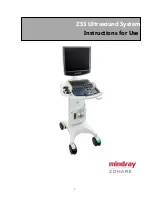
999061 – Revision A
P a g e
|
20 of 28
10.3
Cleaning
Please follow the cleaning guidelines below on cleaning and disinfecting the Transfer Aid.
10.3.1
General cleaning
It is recommended to clean the Raiser and accessories before the use by a different patient, reducing the risk of
cross–contamination.
The exterior of the Raiser can be cleaned using a damp soapy cloth for general cleaning duties. Please ensure the
cloth is damp and not wet. Ensure the exterior of the device is dry after cleaning. Dry using a clean dry cloth.
10.3.2
Disinfecting (if necessary)
Should the Transfer Aid require a more thorough clean, the use of the Actichlor™ disinfectant product (which is widely available
in tablet form and used throughout the health care industry) is recommended.
Follow the manufacturer’s safety instructions for the use of the cleaning product before use to ensure safe use for
the operator and the patient.
Ensure the cloth is damp before the cleaning process.
Application is through a clean damp cloth applied to wipe the device down. Use in the following dilutions to ensure an effective
clean:
•
Actichlor™ dissolvable chlorine tablets provide a concentration of 1000 ppm of available chlorine (0.1%) per 1 tablet
•
1 tablet (1.7g formed tablet (x1)) will create a virucidal solution, diluted in 1 litre of water to provide effective means to
clean a “dirty” device. This is also ideal for use after an outbreak of the Norovirus/winter vomiting and can be used as a
precaution against C.Diff. It is effective against viruses, bacteria, spores, yeasts and moulds.
•
The contact time against the outer components of the device should be for 5 minutes to prevent any virucidal
infections without a degradation to the functionality of the device. 5 minutes is a recommended contact time. The
device can withstand a longer contact period but the 5 minute recommendation as a minimum must be followed to
provide an effective cleaning regime.
•
Blood spills should be dealt with by an increased concentration of the solution – please refer to the instructions on the
manufacturers product labelling.
Dilution chart
Product used as
Device condition
Concentration
(ppm)
Dilution qty* (l)
Tablets per
1l (0.26gal)
Contact
time
(minutes)
Bactericidal
Clean
200
5 (1.32gal)
1
1
Dirty
1000
1 (0.26gal)
1
5
Yeasticidal
Clean
200
5 (1.32gal)
1
1
Dirty
1000
1 (0.26gal)
1
5
Fungicidal
Clean
2000
1 (0.26gal)
2
15
Dirty
5000
1 (0.26gal)
5
15
Mycrobactericidal
Clean
1000
1 (0.26gal)
1
15
Dirty
5000
1 (0.26gal)
5
15
Virucidal
Clean
500
2 (0.53gal)
1
5
Dirty
1000
1 (0.26gal)
1
5
Sporcidal (C.Diff)
Clean
1000
1 (0.26gal)
1
10
-
-
-
-
-
Sporcidal
Clean
5000
1 (0.26gal)
5
10
-
-
-
-
-
* Dilution is made with water. DO NOT dilute within any other medium.
•
When diluted in water, one tablet gives 1000ppm of available chlorine.
•
The concentration of the solution depends upon whether the object being cleaned is noticeably dirty (indicated
in the table by “Device condition”.
Table 10
Summary of Contents for Raiser
Page 1: ...Doc No 999061 Revision of document A Revision Date 19 04 21 Raiser Transfer Aid User Manual...
Page 23: ...999061 Revision A P a g e 23 of 28...
Page 24: ...999061 Revision A P a g e 24 of 28...
Page 25: ...999061 Revision A P a g e 25 of 28...
Page 26: ...999061 Revision A P a g e 26 of 28 User notes...
Page 27: ...999061 Revision A P a g e 27 of 28 User notes...









































